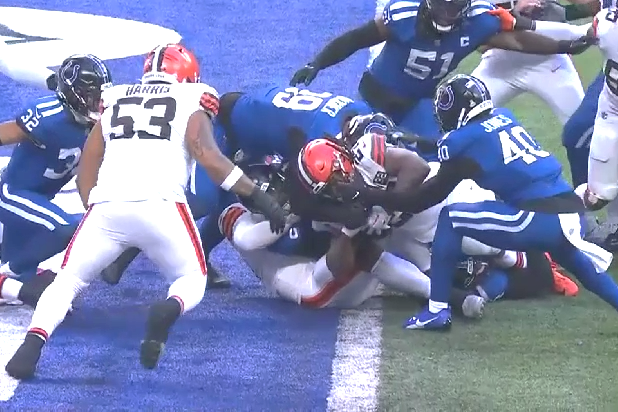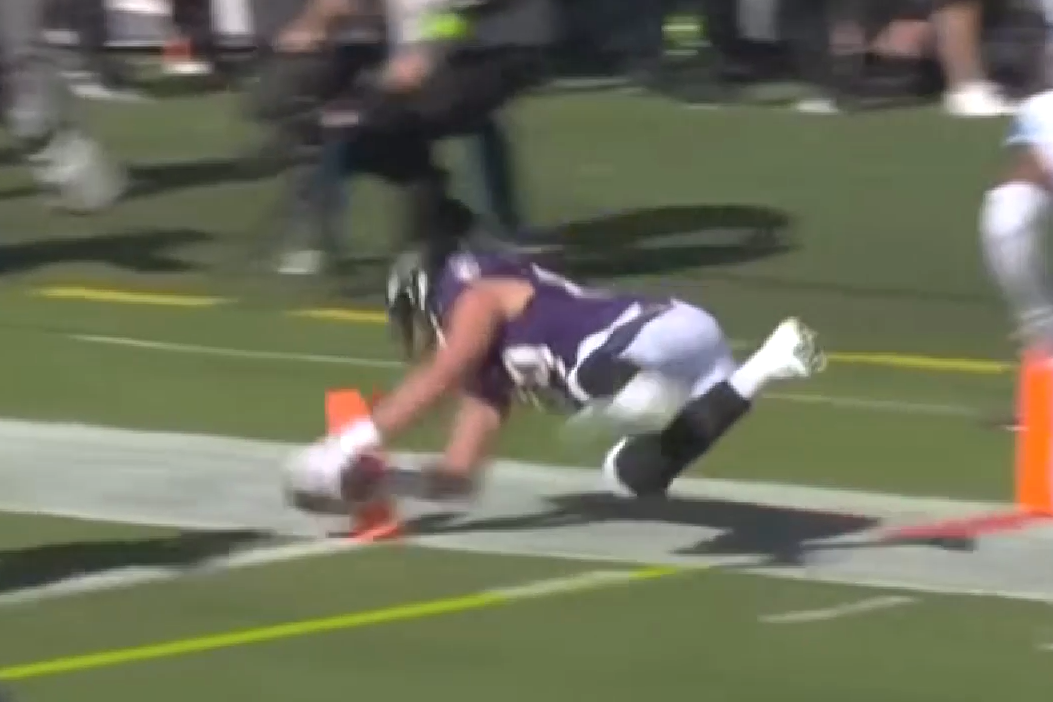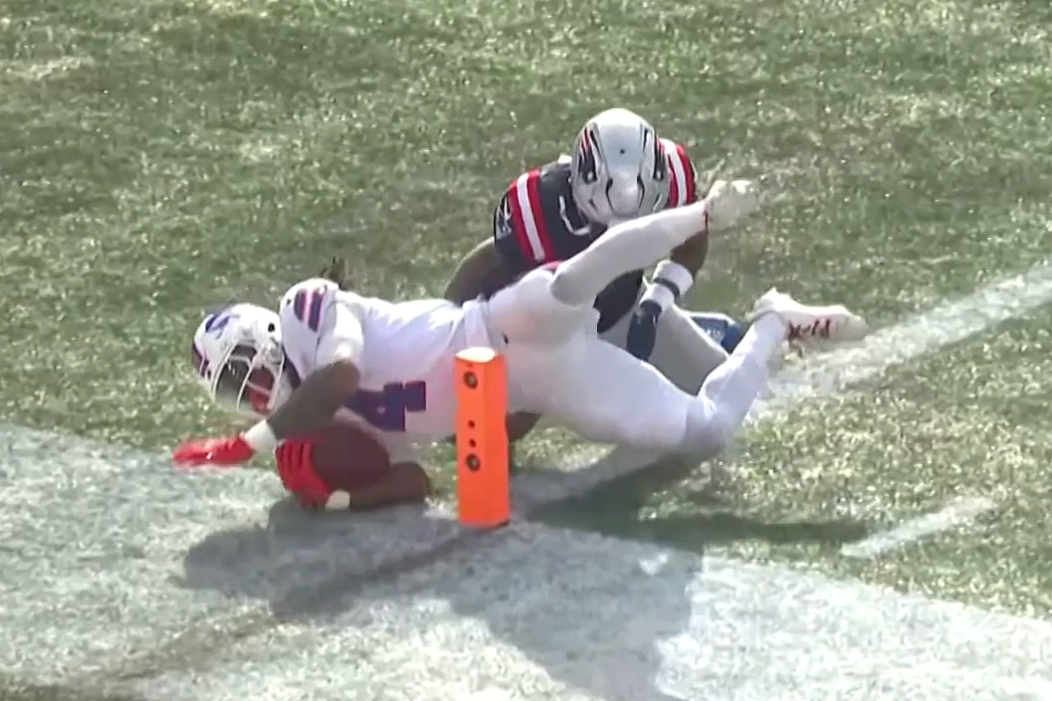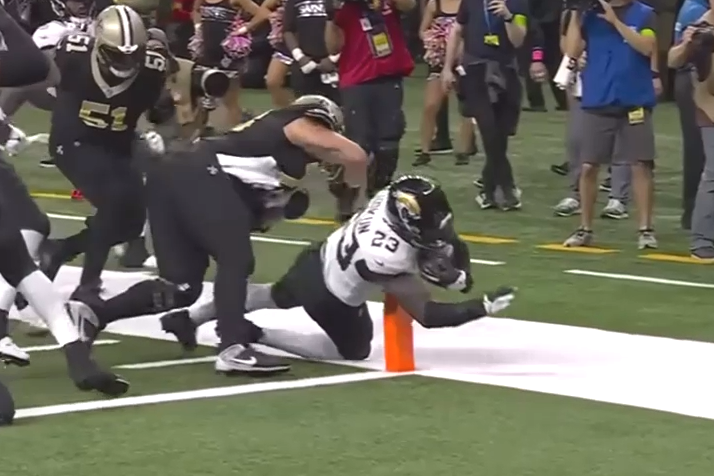13 Games, Oct. 19/22/23, 2023
44566 +2/232\\
Week 7: 64 touchdowns, 4 ATDs
CLE@IND: A game-deciding ATD
Love it or loathe it — the existing break-the-plane rule is a Godsend if it gives your favorite team a clutch six points. And it’s a dagger to the heart if your team’s defense successfully keeps the other team out of the end zone, but the opposition gets awarded a fishy-looking touchdown due to a rule that suddenly seems questionable.
The editor of this site is a native of northern Ohio and a long-suffering follower of hard-luck Cleveland sports teams. He is no fan of the break-the-plane rule, yet even he must concede he felt weirdly relieved when Kareem Hunt, on Cleveland’s fourth attempt to score from the 1, was ruled to have broken the plane with 15 seconds left in the game, giving the Browns a 39-38 win.
It’s evident Hunt did break the Great Invisible Plane with his goal-line surge, yet he never touched the end zone. To us, that’s not worthy of six points, not even if your heart holds a soft spot for the team that benefits from the call.
What we’re rooting for at this site is a logical rule: A play is only ruled a touchdown when a) the ball carrier makes first contact with some portion of the end zone, and b) the ball is carried to or beyond the goal line.
Colts’ fans will grumble, rightly, that this play was set up by some questionable calls against Indianapolis on preceding plays. Then again, Colts’ CB Jaylon Jones (40) got away with yanking Hunt’s facemask during the scoring play. Should judgment calls, such as pass interference, be reviewable? The league gave that a try in 2019 but abandoned it after one season. Maybe that idea will someday be revisited. Not likely, but fans can hope. Hocus Bogus Rating: 4.5
Video and image: CBS Sports

DET@BAL: Into the ether, part 1
The drive that led to this airspace touchdown by Baltimore tight end Mark Andrews involved eight plays, 92 yards, and 3 minutes 47 seconds. Yet according to our exclusive Fix the Rule plane-buster clock, the ball in Andrews’ hands spent 0.02146 seconds above the goal line as Andrews crashed into the pylon and then subsequently landed far out of bounds. That blip of time spent in the goal line’s troposphere, per the existing rule, merits six points.
In contrast, it is our belief that awarded a touchdown a ball carrier must make contact with the end zone, not just whiff through its airspace. In a contact sport, a ball carrier should be required to touch the game’s designated scoring area. Is that not just sensible? Rating: 4

Video and image: Fox Sports
BUF@NE: Into the ether, part 2
Like Mark Andrews above, Buffalo’s James Cook spent a split second in the goal line’s airspace before landing out of bounds — long enough, per the existing break-the-plane rule, to qualify for (to us) an unmerited six points.
And poor Jalen Mills (2) of New England. The eight-year defensive back gets no credit for blocking Cook’s path to the end zone.
As previously explained, we believe an untouched end zone should mean no touchdown. Thus we rule Cook’s reception and run a Nix Six. Rating: 4

Video and image: CBS Sports
JAX@NO: Into the ether, part 3
Based on our frame-by-frame breakdown of this goal-line dive by Jacksonville linebacker Foyesade Oluokun, the ball may not have passed over the goal line. But if it passed through the pylon’s airspace, which is out of bounds, by rule that’s enough to qualify for six points. We find that amazing, and also absurd.
The existence of such strange scoring exceptions is why we argue for a rule that uses an objective point of reference — ball carrier making contact with the end zone — to determine a valid touchdown. Rating: 4

Video and image: NFL Network/Amazon Prime
